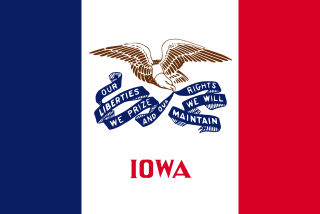
The flag of Delaware consists of a buff-colored diamond on a field of colonial blue, with the coat of arms of the state of Delaware inside the diamond. Below the diamond, the date December 7, 1787, declares the day on which Delaware became the first state to ratify the United States Constitution. The colors of the flag reflect the colors of the uniform of General George Washington.

The flag of the state of Iowa is a vertical tricolor flag designed by Dixie Cornell Gebhardt in 1917. Iowa, United States legislators officially adopted the flag in 1921.

The flag of Oklahoma, also known as the Oklahoma flag, is a rectangular field of sky blue on which is placed an Osage war shield with six crosses and seven pendant eagle feathers above the word 'Oklahoma' in white. Superimposed onto the crosses of the war shield is a calumet and an olive branch.

The flag of Indianapolis has a dark blue field with a white five-pointed star pointing upwards in the center. Around the star is a circular field in red. Surrounding the red field is a white ring, from which extend four white stripes from top to bottom and from hoist to fly, thus creating four equal quadrants in the field. The stripes are about one-seventh the width of the flag, with the white ring the same width as the stripes. The diameter of the red circle is about two-ninths the width of the flag.

The Great Seal of the State of Illinois is the official emblem of the U.S. state, and signifies the official nature of a document produced by the state of Illinois. The flag of the state of Illinois consists of the seal of Illinois on a white background, with the word "Illinois" underneath the seal. The present seal was adopted in 1869, the flag bearing the central elements of the seal was adopted in 1915, and the word Illinois was added to the flag in 1970. In a 2001 survey by the North American Vexillological Association, the flag of Illinois was ranked 49th out of 72 different flags of states and territories, mainly in the US and Canada.

The city flag of Los Angeles consists of a background of three notched stripes of green, gold and red. The flag was designed by Roy E. Silent and E.S. Jones in 1931 for the Los Angeles sesquicentennial from 1781.

The flag of Madison, Wisconsin, includes a sky blue background with a diagonal white stripe that goes from the bottom left corner to the top right which symbolizes Lake Mendota, Lake Monona and the isthmus between them. At the center of the flag is a black cross, which symbolizes the four lakes, as well as the cross shape of the Wisconsin State Capitol. The gold circle in the middle represents the Wisconsin State Capitol's dome.

The flag of Birmingham was designed by Idyl King Sorsby for the occasion of the semicentennial of the city of Birmingham, Alabama in 1921. The flag was officially adopted as the city's flag on August 18, 1925.

The flag of Vancouver was adopted by the Vancouver City Council on May 17, 1983. It was designed by Robert Watt, the director of the Vancouver Museum at the time, and later the Chief Herald of Canada. It features a white field with five wavy blue barrulets, and a green pentagon on the hoist side surmounted by a gold shield with the city badge, which consists of a mural crown with crossed axe and paddle.

The flag of Denver is the official flag of the City and County of Denver in Colorado. It was designed by a North High School student, Margaret Overbeck, and adopted in 1926. A zigzag white stripe horizontally separates a red field below from a blue field above, in which is centered a yellow circle, together forming a stylized depiction of the Sun in a blue sky above snow-capped mountains. The color yellow symbolizes gold in the state's hills, and red the colored earth to which the word colorado refers. The circle's centered position symbolizes Denver's central location within the state. The white zigzag symbolizes Colorado's Native American heritage.

The flag of St. Louis, Missouri, consists of a solid red background and three thick, wavy lines colored blue and white extending from the top left corner, bottom left corner, and center right edge. At the intersection of these lines there is a yellow disk containing a blue fleur-de-lis.

The municipal flag of New Orleans is the representative banner of the U.S. city of New Orleans, Louisiana. The flag has a large white field that contains three gold fleurs-de-lis and is bordered on the top by a red stripe and from below by a blue stripe. The presence of the fleur-de-lis, a stylized depiction of a flower and a traditional French symbol demonstrates the city's French heritage and strong ties to France, while the presence of the design being a Spanish fess demonstrates the city's Spanish heritage and strong ties to Spain.

The flag of Fort Wayne, Indiana, was adopted as the city's official flag by City Council on June 26, 1934. The pall design includes two diagonal white stripes converging in the circular center to form a horizontal white stripe. Red silhouettes of a Miami Native American head, a French fleur-de-lis, and a British lion grace a navy blue field. A red blockhouse is located at the center of the converging stripes, with the settlement's founding date and city name.

The flag of Knoxville, Tennessee, was officially adopted by municipal ordinance on October 16, 1896. It is the third oldest official city flag in the United States and the oldest flag of any state or city governmental entity in Tennessee.

The flag of San Antonio is the official municipal flag of San Antonio. The sketch of the flag's design, drawn by Spanish–American War veteran William W. Herring, was dated May 28, 1933. The design saw significantly more usage than the official flag, but was never officially adopted until 1976. The current flag is a slightly modified version of Herring's design, most notably removing the text formerly displayed.

The flag of San Jose is the official municipal flag of San Jose, California. The current design, a triband of gold on top, white in the middle, and blue on the bottom with the city's official seal in the center, has been the official flag since 1984.

The flag of Austin is the official municipal flag of Austin, Texas. The flag simply consists of a white field with the seal of Austin without the surrounding circle of text. Below the seal of Austin is the text "CITY OF AUSTIN", written in blue and arched upwards.

The flag of Columbus is the official municipal flag of Columbus, Ohio. Its current design is a yellow, white, red vertical triband with the city seal on a blue field. Officially, the flag was adopted in 1929, although it is unknown if the flag was ever flown when it was first adopted.

The flag of Burlington, Vermont was adopted by the Burlington city council on November 27, 2017 during the mayorship of Miro Weinberger. It is five horizontal, zig-zag stripes of blue, white, green, white, and blue.
The flag of Earth is a concept of a possible flag design meant to symbolize the planet Earth, humankind, or a possible world government.
























